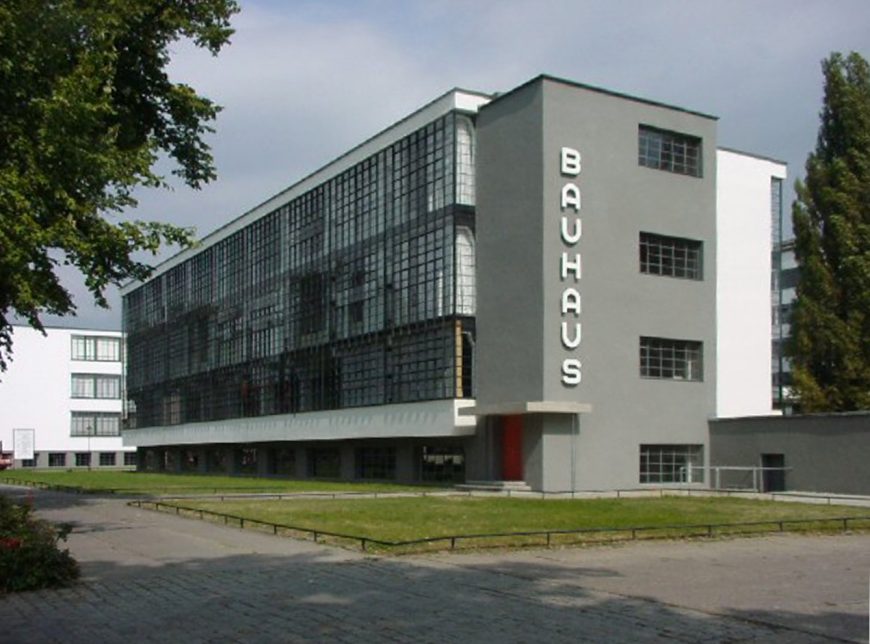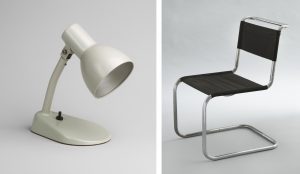
Left: Marianne Brandt, Kandem Bedside Table Lamp, 1928, lacquered steel, 23.5 x 18.4 cm (MoMA). Right: Marcel Breuer, Chair (model B33), 1927-28, chrome-plated tubular steel with steel-thread seat and back, 83.7 x 49 x 64.5 cm (MoMA).
The Bauhaus was an art and design school in Germany whose importance is astonishing given its very brief and tenuous existence. The desk lamp and chair illustrated here are so familiar and so simple that they don’t seem to have required a designer, but they were as radical in their time as they are commonplace now, and their apparent simplicity was the result of a thoughtful and meticulous design education and design process that remains a model today.
During its fourteen years of existence the Bauhaus was forced to change location three times and was ultimately closed as a result of political pressure from the Nazi party. Founded by Walter Gropius in 1919, the school originally had three aims: to abolish the “arrogant” distinction between artist and craftsperson by recognizing the knowledge and skills common to both; to mobilize all arts and crafts towards the creation of total design environments; and, to foster links between the school and local manufacturers.
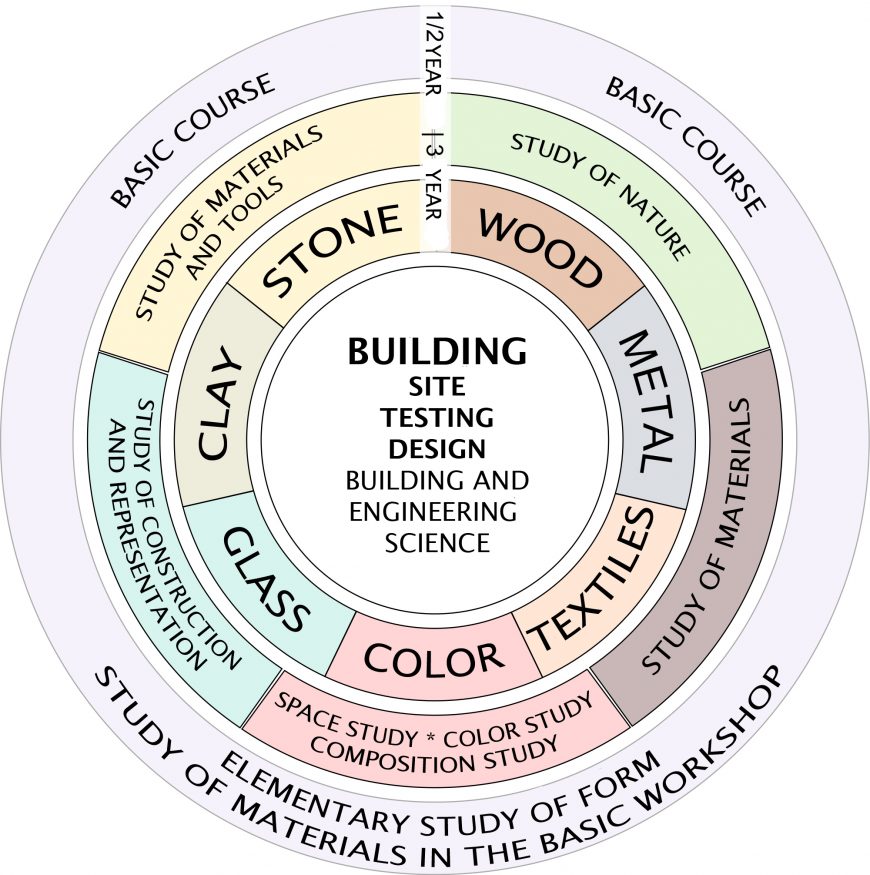
Diagram of the Bauhaus curriculum (image: SuperManu, CC BY-SA 3.0)
Art education and the “Vorkurs” (preliminary course)
The Bauhaus program of study is diagrammed above as a circle. Students began in the outer ring with the half-year Vorkurs or preliminary course (later expanded to a full year) before moving into one of several workshops to concentrate on a specific medium such as ceramics, woodworking, weaving, metalworking, and so on. Once they had achieved a degree of proficiency in their chosen medium all students converged again in Bau (building), to construct total environments, designing everything from the architecture to the furniture, carpets, dishes, and flatware.
The Vorkurs, which taught skills common to all areas of art and design, was one enduring innovation of the Bauhaus. Today’s art students will recognize in the Vorkurs the progenitor of their first-year 2-D Design and 3-D Design “foundations” courses. The original head of the Vorkurs was a charismatic Swiss art teacher named Johannes Itten, a follower of Mazdaznan (related to the ancient Persian religion Zoroastrianism) who wore monk-like clothing and encouraged students to meditate, do breathing exercises, and eat a vegetarian diet as aids to creativity.
Projects assigned in the Vorkurs were free-form and generally without practical application. They were intended to develop students’ perception, creativity, and understanding of materials. For one typical project Itten collected disparate materials such as wool, rope, and wood shavings.
The students had to feel these sequences of textures with their fingertips, their eyes closed. After a short while their sense of touch improved dramatically. I then asked them to make texture montages of contrasting materials. Fantastic structures were produced and their effects were completely novel at the time. Johannes Itten, Design and Form: The Basic Course at the Bauhaus and Later (London: Thames & Hudson, 1975), p. 34
Experimental constructions
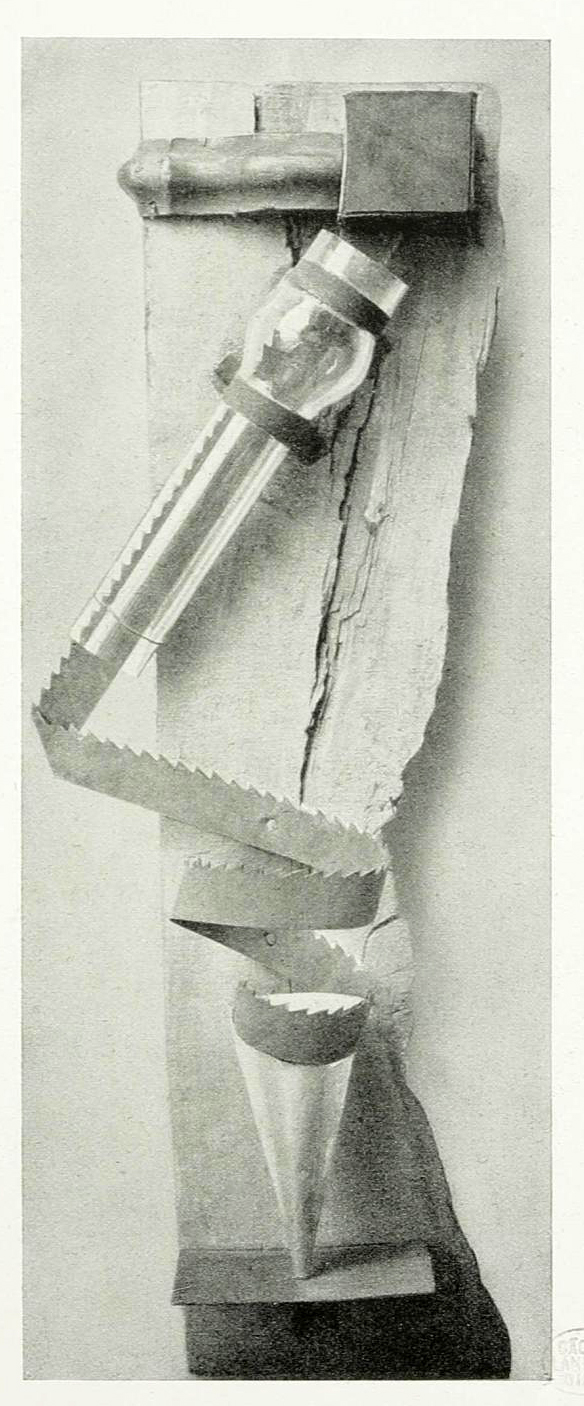
Moses Mirkin, Contrast study in various materials, 1920, photo of the original work as it appeared in the 1923 Bauhaus exhibition catalog
Very few of these Vorkurs projects have survived as they were only intended to be exercises. The work above is described in the 1923 Bauhaus exhibition catalog as a “combined contrast effect: material contrast (glass, wood, iron), contrast of expressive forms (jagged-smooth); rhythmic contrast.” In addition to demonstrating these formal contrasts, its purpose was to understand the nature and potential of different materials.
For example, the wood is left rough and unfinished in order to demonstrate its grain, texture, and color variations. Similarly, the saw blade shows the dull sheen of its surface and has been curled into a spiral to demonstrate the flexibility of metal. The rust on the saw blade’s surface and the knots and splits in the wood are not sanded or polished; instead, they are featured as qualities of those materials that need to be understood by the design students who will be working with them.
From craft to industry
The early Bauhaus concentrated primarily on hand-made crafts, but it soon became evident that, in order to survive, the school needed to reorient its goals toward industrial production. Bauhaus headmaster Walter Gropius asserted in the keynote address for the school exhibition of 1923, “The Bauhaus believes the machine to be our modern medium of design and seeks to come to terms with it.” [1]
Itten, whose spiritual and expressionist orientation did not fit with these aims, was replaced by Laszlo Moholy-Nagy, and later Josef Albers, as head of the Vorkurs. The traditional medieval titles from craft workshops initially used in the Bauhaus, where instructors were called “Masters” and students were called “Apprentices” or “Journeymen,” were replaced by the more modern titles of professor and student.
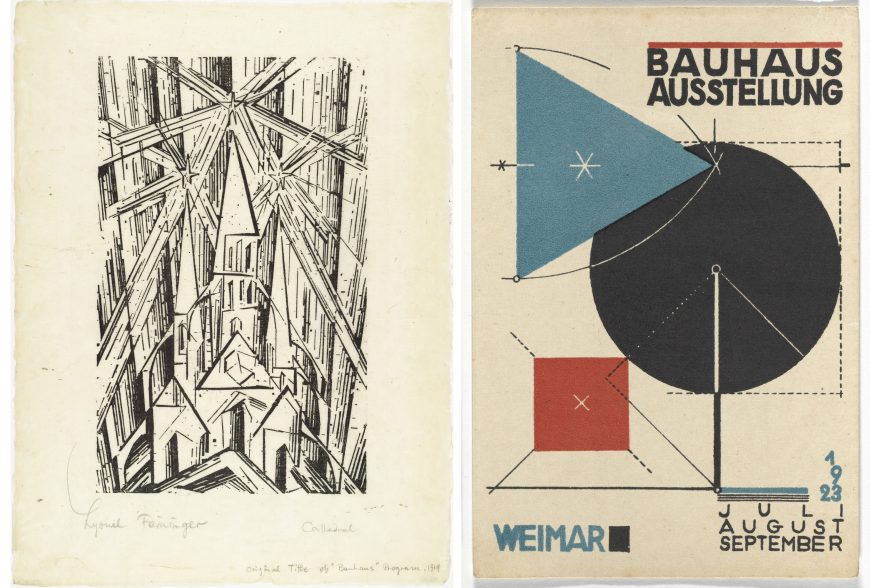
Left: Lyonel Feininger, Cathedral, cover for Program of the State Bauhaus in Weimar, 1919, woodcut, 41 x 31 cm (MoMA); right: Herbert Bayer, Bauhaus Exhibition poster, 1923, lithograph, 15 x 10 cm (MoMA).
The reorientation toward the modern machine age is most obvious in products designed by the Bauhaus for mass production, but it is also visible in the graphic branding of the Bauhaus itself. In 1919, the founding manifesto of the Bauhaus was published with a cover by Lyonel Feininger that featured a cathedral crowned by three radiant stars. Both the medieval subject and the woodcut technique are deliberately old-fashioned, reflecting the guild structure of the school itself and its emphasis on hand making and personal expression.
By contrast, the poster designed for the 1923 exhibition is a lithograph, a more modern printmaking technology. It uses only rational geometric shapes and the primary colors red and blue, along with black and the white of the paper. Dotted lines and arcs made by a compass reinforce the overall sense of precise, mechanical execution, very different from the uneven, expressive marks of Feininger’s print. Even the letter forms reinforce the impression of clean, rationalized modernity: sans-serif, upright, and with a consistent (monoline) weight. Such “modern” typefaces are very familiar today, but were quite different from the medieval blackletter or gothic typeface that was common in Germany until the 1940s.
The Bauhaus is dead … long live the Bauhaus
In 1925, the Bauhaus was forced to flee from its original location in Weimar, Germany. The right-wing nationalists who came to power in the region saw the school as a hotbed of foreigners sympathetic to Communism. The school lasted only seven years in its next location, Dessau, before being forced to move to Berlin. When the Nazi party came to national power under Chancellor Adolf Hitler in 1933 the Bauhaus closed for good.
Despite its relatively brief existence, the Bauhaus had an enormous influence on our contemporary visual environment. Fleeing Nazi Germany, its professors disseminated the school’s curriculum and ideals across the United States. Bauhaus founder Walter Gropius went on to teach at the Harvard School of Design, along with furniture designer Marcel Breuer. Vorkurs instructors Moholy-Nagy and Josef Albers also continued their influential teaching careers: Moholy-Nagy at the New Bauhaus in Chicago and Josef Albers at Black Mountain College in North Carolina and Yale University in New Haven, CT.
Generations of art and design students have absorbed their instruction not only directly, in foundation courses that adopt the aims and sometimes sometimes even exact projects of the Bauhaus Vorkurs, but also by osmosis, living in dorms, sitting in chairs, and using desk lamps that are the direct descendants of Bauhaus designs.
Notes:
- Cited in William J. R. Curtis, Modern Architecture since 1900 (Upper Saddle River, NJ: Prentice Hall, 1996), p. 193.
Additional resources:
Bauhaus: Building the New Artist at the Getty Research Institute
Magdalena Droste. Bauhaus: 1919-1933 (Köln: Taschen, 2006).
Elaine S. Hochman. Bauhaus: Crucible of Modernism (New York: Fromm International, 1997).
Frank Whitford. Bauhaus (New York and London: Thames and Hudson, 1984).

